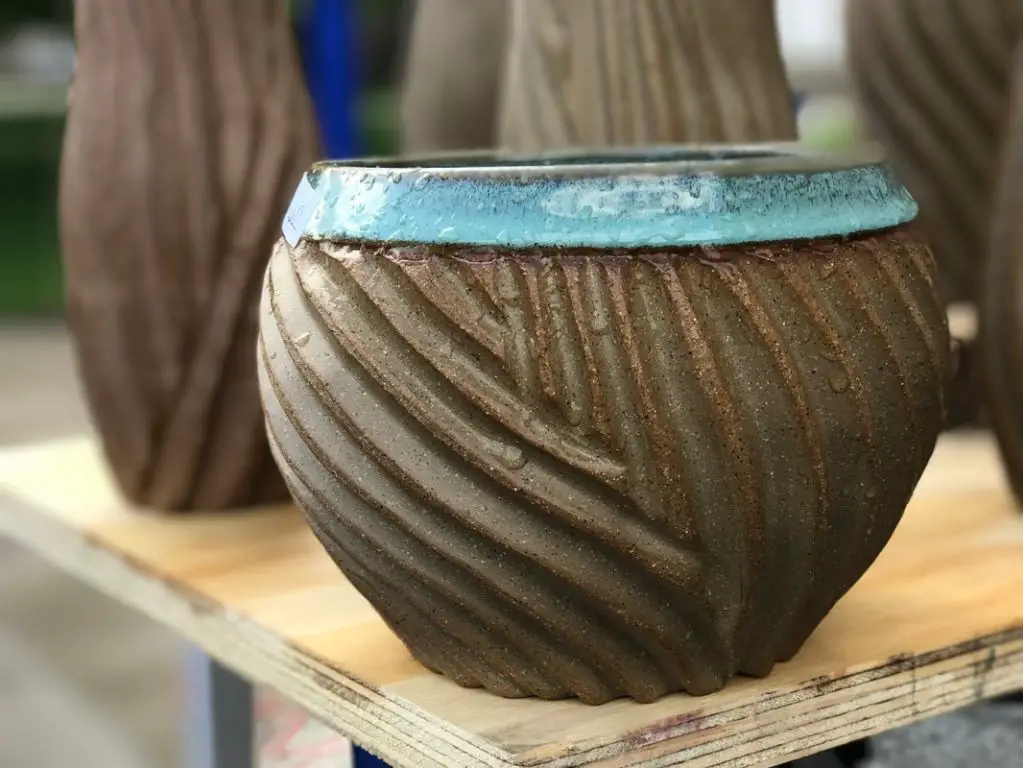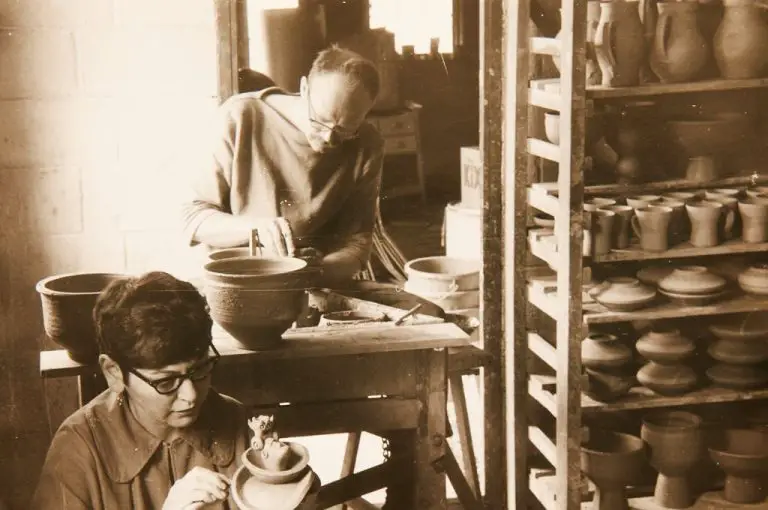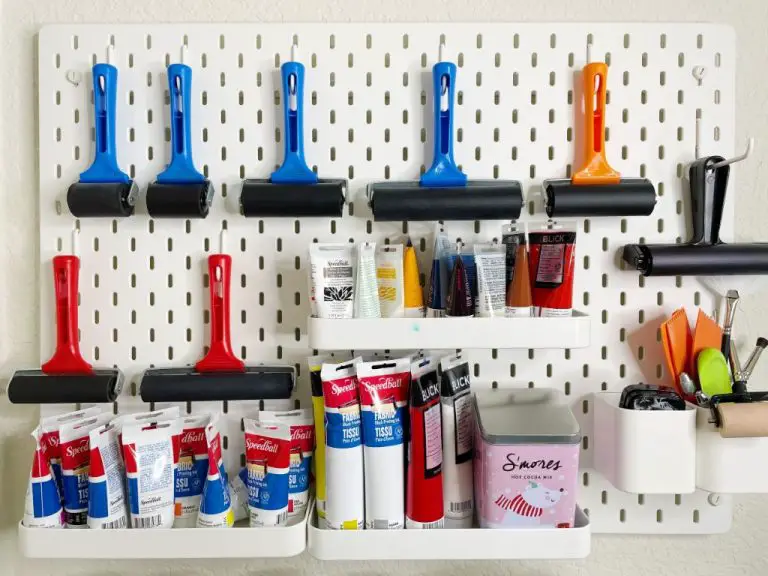What Are Some Examples Of Ceramic Work?
Ceramic art encompasses any objects made out of clay bodies and fired in high temperatures to achieve permanent hardness and durability. Ceramics have been created across the world for thousands of years, with evidence of pottery vessels dating back over 20,000 years in China and Japan (1). The earliest ceramic objects were made from clay for functional uses like cooking pots and containers. Over time, ceramic techniques expanded into decorative and sculptural works of art.
There are several major techniques used in ceramic art:
- Handbuilding – shaping clay by hand into sculpture or utilitarian objects like bowls and pots
- Wheel Throwing – using a potter’s wheel to create vases, plates, cups and other vessel forms
- Slipcasting – pouring liquid clay into a plaster mold to create multiple identical pieces
- Ram pressing – compressing clay into a mold using pressure
- Jiggering – rotating clay against a shaped tool to create a vessel
This article will provide an overview of some of the most common examples of ceramic artwork, including pottery, sculpture, tiles, tableware, jewelry, figurines, and industrial ceramics.
(1) https://en.wikipedia.org/wiki/Ceramic_art
Pottery
Pottery is one of the oldest forms of ceramic work, dating back thousands of years. Pottery is made from clay that is shaped and then fired at high temperatures in a kiln to harden it. There are three main types of pottery – earthenware, stoneware and porcelain (https://deneenpottery.com/pottery/). Earthenware is fired at lower temperatures and is more porous and prone to chipping. Stoneware is stronger and non-porous. Porcelain is the most refined type of pottery, translucent and extremely hard after firing at very high temperatures (https://en.wikipedia.org/wiki/Pottery).

Pottery serves both functional and decorative purposes. Functional pottery includes objects like plates, bowls, mugs and vases for daily use. Decorative pottery encompasses artistic pieces like sculptures, figurines and decorative vases. The earliest pottery was primarily functional, used for cooking, storage and transport. Over time, decorative pottery developed alongside the functional, showcasing artistic techniques and creativity.
Sculpture
Ceramic sculptures and figurines have a long history as both decorative and functional objects. Some of the earliest ceramic sculptures were created in ancient China, such as the famous Terracotta Army built for the first emperor of China in the 3rd century BCE (source). This enormous funerary art collection features over 8,000 life-size ceramic soldiers, horses, and chariots.
Ceramic sculpture flourished again during the Renaissance, as artists experimented with different styles and techniques. Majolica glazed ceramic sculptures became popular decorative items. In the 20th century, ceramic sculpture became recognized as a serious artistic medium, with sculptors like Pablo Picasso and Henry Moore creating abstract ceramic works.
Contemporary ceramic sculptors work in a variety of styles from realistic to abstract. Some create conceptual narrative sculptures, while others focus on form, texture, and glazing techniques. Well-known modern ceramic sculptors include Peter Voulkos, Viola Frey, Arlene Shechet, and Yeesookyung (source). Ceramic sculptures are valued for their durability and ability to convey artistic visions through three-dimensional form.
Tiles
An important type of ceramic work is tiles, which can serve both decorative and functional purposes in architecture and design. Ceramic tiles have been used to create colorful murals, mosaics, and accents on floors, walls, countertops, and more.
Tile makers use brightly colored glazes and intricate designs to produce eye-catching ceramic tiles. The glazing process allows for a wide range of colors and effects like crackling, metallic sheens, or iridescence.
Ceramic tiles are often arranged into murals depicting scenes, patterns, or pictures. Mosaic murals made of small, intricately placed tiles have been created by artisans for thousands of years. Modern mural tiles continue this tradition with colorful contemporary designs.
In addition to decorative murals, ceramic tiles have many functional uses in architecture and design. They are durable, easy to clean, and water resistant, making them ideal for kitchens, bathrooms, patios, pools, and other high-traffic areas. The variety of colors, shapes, textures and patterns available in ceramic tile allows for great flexibility in design.
Tableware
One of the most common uses of ceramic art is for tableware like plates, cups, and bowls. Ceramic materials like porcelain and stoneware are valued for tableware because they are durable, stable, and can be decorated in vibrant colors and patterns. Many artisans create beautiful handmade ceramic tableware with unique decorative glazes and finishes.
For example, the company Fable sells a popular ceramic dinnerware set made of stoneware that is oven, microwave, and dishwasher safe. The colorful patterns and glazes make these pieces decorative as well as functional. Small ceramic dishes like the Everything Dish from Earth + Element can be used for spices, condiments, dips, and more. The range of colors and sizes allow people to mix and match pieces.
Ceramic tableware is valued for both its decorative qualities and its durability. The ceramic material allows tableware to be brightly colored, hand-painted with patterns, and finished in glossy or matte glazes while also being chip and scratch resistant enough for daily use.
Jewelry
Ceramics are a popular material for creating jewelry like beads, pendants, rings, and more. Ceramic jewelry stands out with the use of bright, vibrant glazes in an endless range of colors and effects. Glazes allow ceramic artists to get very creative with patterns, shapes, and designs.
The hard, durable nature of fired clay makes it ideal for jewelry that can stand up to daily wear without chipping or breaking. Ceramic pieces maintain their color and finish much longer than materials like plastic or resin as well. Jewelry makers appreciate working with clay because it can be shaped and molded into organic, flowing forms.
Some examples of ceramic jewelry include:
- Beads – Both handmade and molded beads in various shapes and sizes
- Pendants – Unique necklace pendants showcase glazes
- Rings – From simple band rings to sculptural rings
- Earrings – Studs, hoops, chandeliers, and more unique designs
- Bracelets – Ceramic links or beads incorporated into bracelet designs
The limitless possibilities with glazes and firing techniques make ceramics an ideal choice for small-scale, wearable artworks. Jewelry also represents an accessible entry point to ceramic art for many creators and consumers.
Sources:
https://www.pinterest.com/cocospdoni/
http://www.daiwen123.com/a/yishusheji/2023/1208/24742.html
Figurines
Ceramic figurines have been created for thousands of years across many cultures. Regional styles and cultural motifs are often depicted in ceramic statues, dolls, and miniatures.
Some of the most popular ceramic figurines are collectibles. In the 1930s, companies like Lefton China and Nippon produced figurines depicting colonial Americana scenes and characters. These vintage ceramic figurines are now highly sought after by collectors.
Hummel figurines from Germany feature charming children and pastoral scenes. They were first produced in 1935 and remain popular collectibles today. Lladró porcelain figurines from Spain showcase intricate, handcrafted details in their figurines of people, animals, and mythical creatures.
In Asia, the tradition of ceramic figurines and miniatures continues today. Japanese ceramics companies like Kutani produce exquisite hand-painted porcelain geisha dolls. while in China, the ancient tradition of tomb figurines provides a glimpse into that culture’s views on the afterlife.
No matter the culture or time period, ceramic figurines continue to showcase regional styles and provide insight into cultures, history, and artistic traditions.
Industrial Ceramics
Ceramic materials are widely used in industrial and technical applications due to their durability, heat resistance, hardness, and other unique properties. Some key uses of ceramics in industry include:
Electronics – Ceramics like alumina and beryllia are excellent electrical insulators and are used to make substrates for integrated circuits and printed circuit boards. Ceramic capacitors, resistors, and other passive components are also common in electronics.
Engines – Ceramic coatings are applied to engine components like pistons and cylinder walls to improve wear resistance and heat management. Ceramic turbocharger rotors also allow engines to operate at very high temperatures.
Cutting tools – Silicon carbide and tungsten carbide ceramics are very hard and abrasion resistant, making them ideal for cutting tool inserts and other wear-resistant parts.
Pumps and valves – Ceramic components like seals, bearings and linings are often used in pumps and valves handling corrosive chemicals, slurries, high temps, etc. Their corrosion resistance allows them to withstand very harsh environments. (source)
Medical implants – Bioceramics like zirconia and alumina are bioinert and hard, making them suitable for medical implants like hip and knee joints that must withstand years of wear.
The unique properties of ceramic materials make them indispensable for many demanding industrial applications where performance, durability, and reliability are essential.
Ceramics in Architecture
Ceramic materials like tiles, bricks, and pipes have been used in architecture and construction for thousands of years. Ceramic tiles are one of the most common architectural uses, covering walls, floors, countertops, and more in many buildings. Glazed ceramic tiles first became popular in medieval Persian architecture, and ornate tilework remains an important decorative element in many architectural styles today, like Spanish Colonial, Art Deco, and Moorish Revival.
Structural clay bricks and pipes emerged as important ceramics in architecture during the Roman Empire. Fired clay bricks allowed for larger and more complex buildings. Ceramic plumbing pipes also enabled advanced water and waste systems in Roman cities. Bricks and pipes continue to be staples of modern construction and infrastructure.
Ceramic facades and ornamentation represent another architectural use. Decorative ceramic tiles, panels, and reliefs have adorned building exteriors for centuries. Some notable examples include the elaborate ceramic facades of buildings designed by Spanish architect Antoni Gaudí, the ceramic murals on Mexico City’s Casa de los Azulejos, and the ceramic scenes adorning the Natural History Museum in London.
Many contemporary architects also incorporate ceramic elements for aesthetic purposes. For example, Austrian artist Cerith Wyn Evans created a series of ceramic chandeliers for the extension of the White Cube gallery in London. Other architects harness ceramics for functional purposes, like thermal insulation or moisture resistance. Overall, ceramics remain a versatile and visually striking material for construction and design.
Sources:
https://www.unstudio.com/en/page/5868/ceramics-in-architecture-featured-contributor-christine-jetten
Conclusion
Ceramic work encompasses a wide range of functional and artistic forms including pottery, sculpture, tiles, tableware, jewelry, figurines, and industrial ceramics used in architecture and engineering applications. As we have seen, ceramics play an important role in culture and society with both practical uses and as an expressive art form.
Pottery and sculpture allow artists to work in three dimensions to create unique pieces imbued with creative vision. Tiles lend themselves to elaborate decorative patterns covering walls, floors, and other surfaces. Tableware such as dishes, bowls, mugs, and vases brighten our everyday lives while serving daily needs. Ceramic jewelry and figurines provide wearable, collectible works of art.
Beyond fine arts applications, industrial ceramics are essential for products ranging from bricks and pipes to aerospace components. Overall, ceramics provide durable, versatile materials to meet functional needs while also enabling free artistic expression.




